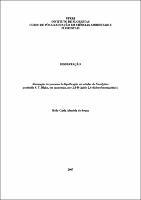Please use this identifier to cite or link to this item:
https://rima.ufrrj.br/jspui/handle/20.500.14407/11170Full metadata record
| DC Field | Value | Language |
|---|---|---|
| dc.contributor.author | Souza, Kelly Carla Almeida de | pt_BR |
| dc.date.accessioned | 2023-12-22T01:48:53Z | - |
| dc.date.available | 2023-12-22T01:48:53Z | - |
| dc.date.issued | 2007-02-15 | |
| dc.identifier.citation | SOUZA, Kelly Carla Almeida de. Atenuação do processo de lignificação em célulasde Eucalyptus urophylla S. T. Blake, em suspensão, por 2,4-D (ácido 2,4-diclorofenoxiacético). 2007. 62 f. Dissertação (Mestrado em Ciências Ambientais e Florestais) - Instituto de Florestas, Universidade Federal Rural do Rio de Janeiro, Seropédica - RJ, 2007. | por |
| dc.identifier.uri | https://rima.ufrrj.br/jspui/handle/20.500.14407/11170 | - |
| dc.description.abstract | A cultura de células em suspensão é uma técnica muito eficiente para o estudo de metabólitos secundários. Através da utilização do 2,4-D (ácido 2,4- diclorofenoxiacético), regulador de crescimento com habilidade de reprimir o metabolismo dos fenilpropanóides, foi realizado um processo de lignificação de células em suspensão de Eucalyptus urophylla a fim de identificar a concentração de 2,4-D mais eficiente para atenuar a produção de lignina in vitro. Este trabalho foi desenvolvido no laboratório de Biotecnologia da Madeira (IF-UFRRJ) onde calos de Eucalyptus urophylla foram produzidos e transferidos para o meio MS líquido suplementado com cinco diferentes tratamentos de 2,4-D (T1: 1 mg/L; T2: 2 mg/L; T3: 4 mg/L; T4: 5 mg/L; T5: 0 mg/L) sem agentes antioxidantes. Por análises no infravermelho e no ultravioleta comprovou-se que em meio MS líquido as células foram capazes de produzir lignina. O tratamento 2 com 2 mg/L de 2,4-D foi o mais adequado para produzir quantidades menores de lignina, ao contrário do tratamento 5 com 0 mg/L de 2,4-D, no qual a ausência deste fitorregulador não reprimiu a produção de lignina. Esta pesquisa abre portas para o estudo da lignina de Eucalyptus urophylla permitindo conhecer melhor o processo de formação desta substância de grande complexidade e de grande importância na área florestal. | por |
| dc.description.sponsorship | Coordenação de Aperfeiçoamento de Pessoal de Nível Superior | pt_BR |
| dc.format | application/pdf | por |
| dc.language | por | por |
| dc.publisher | Universidade Federal Rural do Rio de Janeiro | por |
| dc.rights | Acesso Aberto | por |
| dc.subject | calo | por |
| dc.subject | lignina | por |
| dc.subject | suspensão celular | por |
| dc.subject | callus | eng |
| dc.subject | cell suspension | eng |
| dc.subject | lignin | eng |
| dc.title | Atenuação do processo de lignificação em célulasde Eucalyptus urophylla S. T. Blake, em suspensão, por 2,4-D (ácido 2,4-diclorofenoxiacético) | por |
| dc.title.alternative | Attenuating of lignification process in Eucalyptus urophylla S.T. Blake, in suspension, by 2,4-D (2,4- dichlorophenoxyacetic acid) | eng |
| dc.type | Dissertação | por |
| dc.description.abstractOther | The suspension cell culture is an efficient tecnique to the study of secondary metabolics. Through the utilization of 2,4-D (2,4- dichlorophenoxyacetic acid), growth regulator with ability to restrain the phenylpropanoid metabolism, was carried a process of lignification of suspension cells of Eucalyptus urophylla in order to identify the most efficient 2,4-D concentration to attenuate the lignin production in vitro. This work was developed in the Wood Biotechnology Laboratory (IF-UFRRJ) where callus of Eucalyptus urophylla were produced and transfered to the medium supplemented liquid MS with five different treatments of 2,4-D (T1: 1 mg/L; T2: 2 mg/L; T3: 4 mg/L; T4: 5 mg/L; T5: 0 mg/L) without antioxidants agents. Infrared and ultraviolet analyses proved that, in medium liquid MS, the cells were capable to produce lignin. The treatment 2 with 2 mg/L of 2,4-D was better to produce little amounts of lignin than treatment 5 with 0 mg/L of 2,4-D, in which the absence of this growth regulator did not restrain the lignin production. This research opens new ways for the study of the Eucalyptus urophylla lignin allowing a better knowledge of the formation process of this substance, which has a great complexity and importance in the forest area. | eng |
| dc.contributor.advisor1 | Abreu, Heber dos Santos | pt_BR |
| dc.contributor.advisor1ID | 509.726.507-68 | por |
| dc.contributor.advisor1Lattes | http://buscatextual.cnpq.br/buscatextual/visualizacv.do?id=K4781432Z5 | por |
| dc.creator.ID | 095.998.667-70 | por |
| dc.creator.Lattes | http://lattes.cnpq.br/9033742169177308 | por |
| dc.publisher.country | Brasil | por |
| dc.publisher.department | Instituto de Florestas | por |
| dc.publisher.initials | UFRRJ | por |
| dc.publisher.program | Programa de Pós-Graduação em Ciências Ambientais e Florestais | por |
| dc.subject.cnpq | Recursos Florestais e Engenharia Florestal | por |
| dc.thumbnail.url | https://tede.ufrrj.br/retrieve/14082/2007%20-%20Kelly%20Carla%20Almeida%20de%20Souza.pdf.jpg | * |
| dc.thumbnail.url | https://tede.ufrrj.br/retrieve/18320/2007%20-%20Kelly%20Carla%20Almeida%20de%20Souza.pdf.jpg | * |
| dc.thumbnail.url | https://tede.ufrrj.br/retrieve/24640/2007%20-%20Kelly%20Carla%20Almeida%20de%20Souza.pdf.jpg | * |
| dc.thumbnail.url | https://tede.ufrrj.br/retrieve/30985/2007%20-%20Kelly%20Carla%20Almeida%20de%20Souza.pdf.jpg | * |
| dc.thumbnail.url | https://tede.ufrrj.br/retrieve/37363/2007%20-%20Kelly%20Carla%20Almeida%20de%20Souza.pdf.jpg | * |
| dc.thumbnail.url | https://tede.ufrrj.br/retrieve/43747/2007%20-%20Kelly%20Carla%20Almeida%20de%20Souza.pdf.jpg | * |
| dc.thumbnail.url | https://tede.ufrrj.br/retrieve/50135/2007%20-%20Kelly%20Carla%20Almeida%20de%20Souza.pdf.jpg | * |
| dc.thumbnail.url | https://tede.ufrrj.br/retrieve/56601/2007%20-%20Kelly%20Carla%20Almeida%20de%20Souza.pdf.jpg | * |
| dc.originais.uri | https://tede.ufrrj.br/jspui/handle/tede/449 | |
| dc.originais.provenance | Made available in DSpace on 2016-04-28T14:56:13Z (GMT). No. of bitstreams: 1 2007 - Kelly Carla Almeida de Souza.pdf: 5466279 bytes, checksum: 5e7c5ae2c8e7d5a6076ba4862fd274f1 (MD5) Previous issue date: 2007-02-15 | eng |
| Appears in Collections: | Mestrado em Ciências Ambientais e Florestais | |
Se for cadastrado no RIMA, poderá receber informações por email.
Se ainda não tem uma conta, cadastre-se aqui!
Files in This Item:
| File | Description | Size | Format | |
|---|---|---|---|---|
| 2007 - Kelly Carla Almeida de Souza.pdf | 5.34 MB | Adobe PDF |  View/Open |
Items in DSpace are protected by copyright, with all rights reserved, unless otherwise indicated.

